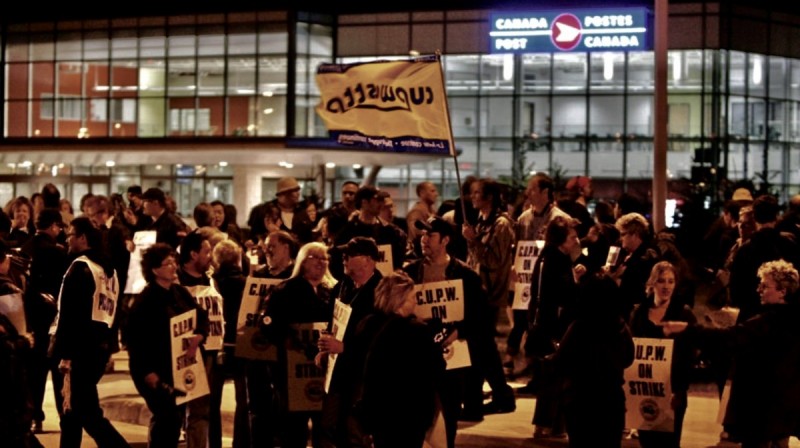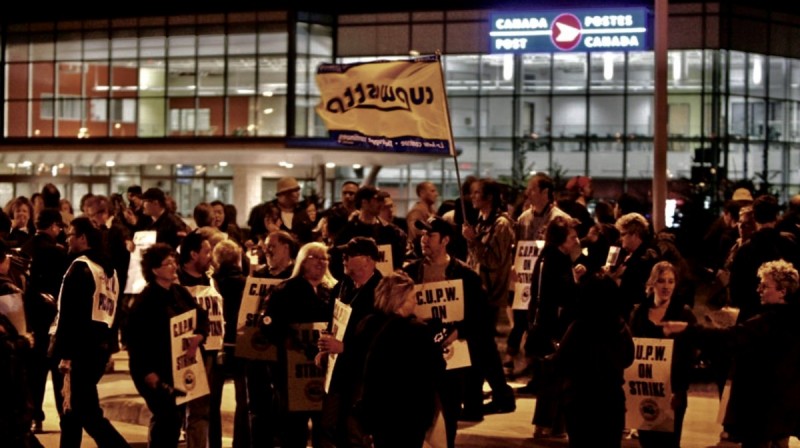CUPW’s difficult choice

CUPW workers picket at the Canada Post processing facility in Winnipeg, June 2, 2011. Photo by Trevor Hagan.
Over the past few weeks, CUPW members across Canada and Québec have been debating whether or not to accept the extension of their collective agreement as proposed by the union’s National Executive Board (NEB). They will have to reach a decision by September 3.
The National Directors in the Atlantic, Québec, Montréal, Toronto, Central and Ontario, Prairies and Pacific regions are unanimous in their support of the recommendation to extend the collective agreement. Unanimity has never been easy to achieve. This is the first time it has happened since the 1990s, as Nancy Beauchamp, rural letter carrier and now national director for the Montreal-Metro region, points out.
The current collective agreement is the result of an arbitrator’s decision that came on the heels of the back to work legislation adopted by Justin Trudeau’s Liberal government on November 26, 2018. CUPW’s national leadership has now negotiated a two-year extension that includes new benefits of various kinds as well as a wage increase. Sylvain Lapointe, former Montréal Local President and National Officer for many years, points out that agreeing to extend a collective agreement imposed by an arbitrator is not unprecedented in the history of CUPW. On three other occasions (1992, 1999, and 2012), after the union was ordered back to work, agreements were reached with Canada Post Corporation that extended the time frame provided for in the legislation.
According to Montréal Local President Alain Robitaille, “Extending the agreement will also allow enough time to assess the shortcomings of the new rights contained in the existing collective agreement and revise the current National Program of Demands. The union hasn’t had enough time to do so since the current collective agreement came into effect.”
Coleen Jones, National Director, Pacific Region, explains that the impact of the pandemic is still with us and that the union needs to prepare for the fourth wave this fall. In the past year and a half, CUPW has had to contend with many problems, including “workers struggling with child care issues, those taking care of elderly relatives or partners who have lost their jobs, families trying to make ends meet on only one income, and so on. Many members need to recover first and then prepare to fightback when necessary.”
In his article for Rank and File discussing the CUPW situation (“‘No’ campaign emerges to kill dubious Canada Post deal”), Doug Nesbitt quotes approvingly the position of the Edmonton Local: “We should never ratify an inadequate contract imposed on us in arbitration. This is not a gain.” However, that argument doesn’t take into account the social and political context in which the negotiations and a possible strike would take place—in particular the pandemic—or the mobilization required to gain public support and avoid back-to-work legislation.
The wage increase has been central to the debate. Some members see it as below inflation. In making its case, the union explains that CUPW’s wage increases of two percent, 2.5 percent and 2.9 percent for the years 2018 to 2021 have been equal to, or better than, those obtained in most collective agreements in recent years. Moreover, the addition of a $500 non-pensionable one-time lump sum represents a 2.8 percent increase in first-year wages over current annual wages.
According to Coleen Jones, “This puts the current wage proposal ahead of what the Canada Border Services Agency (CBSA-PSAC) just obtained (8.08 percent over four years). This alone represents real progress, especially when compared to other unions. CUPW also has a Cost of Living Adjustment Clause (COLA) and all new employees are included in these protections and benefits.”
There are currently thousands of communities without a bank but with access to post offices. Providing financial services will keep these post offices open. Photo by Wayne Worden/Flickr.
Postal banking
In 2016 CUPW launched a major campaign around a proposal for postal banking that was enthusiastically supported by many left-wing organizations. Although postal banking is not the major issue on the table at this point, the union leadership considers it important to move forward with the idea, even if it doesn’t achieve everything it wanted. The union newsletter explains that the agreement provides for the launch of new financial services at Canada Post, in partnership with a Canadian financial institution, and with market testing in select locations by the end of 2021. There are currently thousands of communities without a bank but with access to post offices. Providing financial services will keep these post offices open.
According to Coleen Jones, the partnership with the private sector will serve as a testing ground. It ensures an injection of funds that will help offset losses incurred during the pandemic and create new jobs. Nor does it rule out that the possibility of Canada Post offering its own services down the road.
In a recent CUPW Facebook group post, former National President Mike Palecek remarked that the plan fails to provide a public alternative, writing “it lets the private banks into the public post office.” But this seems to be a departure from the view expressed in an official CUPW document published in early 2016 when Palecek was still president entitled “Postal Banking: A Bank for Everyone.” According to the document: “There are many different models of postal banking. Some postal administrations set up their own bank. Others act as a financial intermediary by providing services in partnership with banking and other financial institutions, such as credit unions.”
A political strategy
There are several factors to consider in a decision to fight a battle over a collective agreement. First and foremost are timing and the capacity to build bargaining power. In an era of back-to-work legislation, it is essential for any public sector union to develop a strategy to win public support. In the present moment, the pandemic has weakened the economy and many people find themselves in precarious situations. Bargaining is never easy and the possibility of a strike always arises. Just weeks away from the federal election, we can’t be sure who will win, but the odds are that the future government will not hesitate to pass back-to-work legislation once again. Will CUPW get the public support it needs? If not, it goes back to square one.
In analyzing this dilemma, it is important to look at the context and the relationship of forces and to weigh possible gains against possible setbacks. But of course we also have to consider the impact of not fighting back now, which explains the willingness of many CUPW members to go ahead with bargaining to redress issues management failed to deal with.
As Jane Marsh, longtime activist and member of the Toronto Local executive, points out, there are many new members in Toronto who want to fight back because the current collective agreement imposed by the arbitrator involved quite a few setbacks. Fighting back and refusing the proposed agreement is, of course, a strategy worth considering provided it has some hope of success and doesn’t leave the members in a worse situation than accepting the extension. Whatever the outcome on September 3, the decision belongs to the members, and the struggle must continue.
Edited with additional content by Andrea Levy.
André Frappier is a regular contributor to CD and a member of the magazine’s coordinating committee. He also serves on the editorial board of the online weekly Presse-toi à gauche and has been a member of the FTQ Montréal Labour Council for many years.

